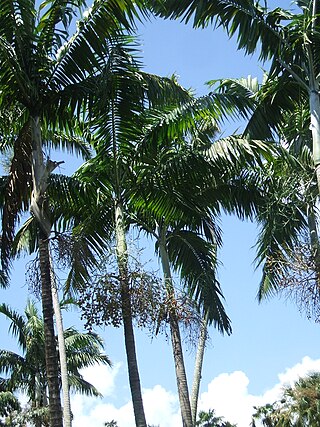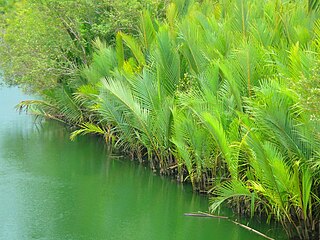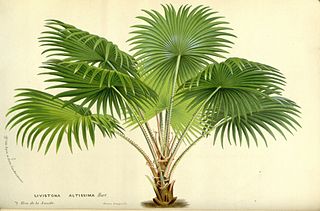
Salacca is a genus of about 20 species of palms native to Southeast Asia and the eastern Himalayas. They are dioecious and pollinated by Curculionidae beetles.

Livistona is a genus of palms, the botanical family Arecaceae, native to southeastern and eastern Asia, Australasia, and the Horn of Africa. They are fan palms, the leaves with an armed petiole terminating in a rounded, costapalmate fan of numerous leaflets.

Trigonostemon is a plant genus of the family Euphorbiaceae and the sole member of its tribe (Trigonostemoneae). It was first described as a genus in 1826. It is native to Southeast Asia, southern China, the Indian Subcontinent, Queensland, and a few islands in the western Pacific.

Saribus rotundifolius, also known as the footstool palm, is a common fan palm found in Southeast Asia. It is a member of the genus Saribus.

Adonidia merrillii, the Manila palm, is a palm tree species native to the Philippines. This palm was cultivated for centuries in East Asia before becoming a staple in the West. It is reportedly naturalized in the West Indies and Florida. It is commonly known as the "Christmas palm" because its fruits become bright scarlet and tend to be that color in winter. This palm is typically fairly small and slender, normally attaining 25 feet or 8 meters in height but has attained over 40 feet in some instances. Most plants maintain 5-7 fronds when young, gradually building up the crown as the palm ages, and sometimes reaches 10-12 fronds when mature.

Medemia argun is a rare species of the palm tree family (Arecaceae) native to Egypt and Sudan. It is the only species in the genus Medemia. The palm's dried dates have been found in ancient Egyptian tombs.

Veitchia is a genus of flowering plant in the family Arecaceae.

Schismatoglottis is a genus of flowering plants in the family Araceae. Members of the genus are similar in appearance and growth habit to those of the genus Homalomena, but the two genera are not closely related. The primary difference is that the leaves of Schismatoglottis are not aromatic. Schismatoglottis are found primarily in tropical parts of Southeast Asia, New Guinea, and Melanesia. The majority of the species are native to the Island of Borneo.

Nypa fruticans, commonly known as the nipa palm or mangrove palm, is a species of palm native to the coastlines and estuarine habitats of the Indian and Pacific Oceans. It is the only palm considered adapted to the mangrove biome. The genus Nypa and the subfamily Nypoideae are monotypic taxa because this species is their only member.
John Dransfield is former head of palm research at the Royal Botanic Gardens, Kew, United Kingdom.

Saribus is a genus of palms, native to Southeast Asia, Papuasia and Pacific Islands. They are fan palms, the leaves with an armed petiole terminating in a rounded, costapalmate fan of numerous leaflets.
Dipterocarpus lowii is a tree in the family Dipterocarpaceae.
Palaquium cryptocariifolium is a tree in the family Sapotaceae. The specific epithet cryptocariifolium refers to the resemblance of the leaves to those of the tree genus Cryptocarya.

Palaquium gutta is a tree in the family Sapotaceae. The specific epithet gutta is from the Malay word getah meaning "sap or latex". It is known in Indonesia as karet oblong.

Saribus woodfordii is a species of fan palm which is native to an area from southeastern Papua New Guinea to the Solomon Islands.
Quercus merrillii is an Asian species of shrubs in the beech family Fagaceae. It has been found on the Island of Palawan in southwestern Philippines and also in the Malaysian parts of the nearby Island of Borneo. It is placed in subgenus Cerris, section Cyclobalanopsis.
Adonidia dransfieldii is a species of Adonidia palm native to Sabah, Borneo, Malaysia. It grows up to 7 metres (23 ft) in height.
Manjekia is a monotypic genus of palm for a species of palm native to Biak island, Indonesia, off the northwest coast of New Guinea. The genus was proposed in 2014.
Saribus chocolatinus is a species of palm tree in the genus Saribus, which is native to Papua New Guinea. It is a fan palm.
Helicia symplocoides is a tree in the family Proteaceae, native to Borneo. The specific epithet symplocoides refers to the leaves' resemblance to those of the genus Symplocos.















